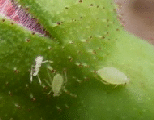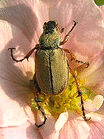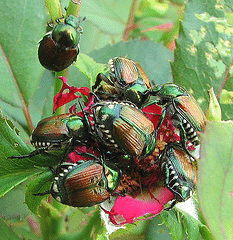Rose Insects
It is sometimes difficult to determine if insects you see on your roses are good guys or bad guys. What you can know for sure, if you use an insecticide to kill bad guys you will also kill the good guys. Until and unless you must stop a problem that is decimating your roses, wait for the good guys to do their job. Many insects that cause damage to your roses will do only that, damage. It is rare that an insect problem will kill your rose bush.
Aphids: There are a tremendous number of aphid varieties, and not all attack roses. Rose aphids and potato aphids are the most common offenders. The adult lays hundreds of eggs on the rose canes. The aphid pierces tender plant material then sucks the liquid out. They do not tend to seriously damage the plant, but certainly cause aesthetic damage, often leaving your rose petals dried and shriveled. Plants attacked by aphids do not grow as vigorously and the aphids often carry disease. You may most often notice their arrival when new growth and buds appear, but they generally hang around all summer and eggs are able to survive winter. Since they love the tender growth, first, stop fertilizing to minimize the food source. There are many predators that feed on aphids, so avoid chemicals that will kill the predators too, give the predators a chance to do their work. Lady bugs, for one, are natural predators of aphids. But ants love the honeydew produced by aphids, and so ants will try to protect them. Keep ants away from rose bushes with sticky traps or baits. The aphids can be sprayed off the plant with a garden hose which usually drowns them. Do this every other day for a week or so, then keep a close eye out to see if any survive and return. If the aphids still are not under control, spray with insecticidal soap or neem oil. Be aware that when sprayed in hot weather, these too can damage your plants.
Thrips: Very tiny yellow or black thrips can be found among the rose petals. They are difficult to see until large numbers dot the blooms. Thrips primarily damage rose blooms, causing the petals to be streaked or spotted with brown, brown edges, or distorted. Thrips are most common in rose gardens with many varieties blooming at various times, providing a constant food source. In most gardens the damage is limited. To help prevent thrips deadhead spent blooms frequently. The application of pesticides is not practical, as they are only effective in the early stages of development when a gardener will not even be aware of their presence. And since they tend to hide deep in the blooms or buds, contact with the pesticide is minimal. Thrips will over winter in leaf and plant litter or grass clumps, so good cleanup in the garden can help reduce the numbers. You can also drench the soil around rose bushes in heavy infestations to drown the pupae. Lady bugs and lacewing larvae are natural predators of thrips.
Rose Chafers: These beetles appear in early June and live about 3 weeks, feeding on fruits, rose blossoms and flowering plants. They are a 3/4 inch long, thin, tan colored beetle with long legs and a reddish brown head. Rose Chafers are most common in the Northeast but can be found in southern, central and western regions as well. The Rose Chafer enjoys not only the flowers of roses, but also peonies, grapes, dahlia, hollyhock, geranium, hydrangea, wisteria and other blooms. Often a very large number will appear on a single plant. Petals are often completely consumed and foliage of a variety of broadleaf plants are skeletonized. You can hand pick them off or try botanical insecticides with a little horticultural oil added, that will help the insecticide stick to the leaves. Organic pyrethrum and rotenone, or chemical Sevin can be applied every 3 to 4 days. If you grow prize rosebushes, you may want to cover the bushes with cheesecloth while the beetles are active in June.
Rose Bud Borers: The two borers that afflict rose bushes are Rose curculios (or rose weevil) which are about 1/4 inch long and bright red with black beaks, and Rose leaf beetles which are about 1/8 inch long, and are shiny blue or green. They both bore into the flower buds preventing bloom. You may simply pick them off the plants and remove and destroy infected buds, or spray with insecticidal soap mixed with pyrethrin. This will also help prevent spread to other plants.
Japanese Beetles: These destructive beetles are about 1/2 long, metallic green, with coppery bronze colored wing covers. They chew small holes in leaves and flowers, often feeding in groups and eating voraciously. They begin on the top of the plant and work their way down, you may find them burrowed head down into flower blooms. Milky spore, or a granular grub control insecticide applied to the lawn/ground will attack the grubs. Milky spore can control the problem for years. Chemical grub control should be applied late in summer, and it is important to follow directions exactly. Chemicals to control the adult beetle include Sevin and Diazinon, and must contact the beetles to be effective. If you object to chemical controls, just pick the beetles off your plants and drop them into a pail of soapy water. Or just drop them on the ground and step on them. For complete information on Japanese Beetle control see the article: Controlling Japanese Beetles.
Spider Mites: Spider Mites are quite common, and several species will attack roses. They are generally found in colonies, are very tiny as pictured here, and live on the underside of leaves. If the population grows large enough they will spread to both sides of the leaves.
Signs of infestation are yellowed, dry looking leaves with small white dots, and sometimes you will find webbing on the stems and leaves. Since they are to tiny you may not even see them. Avoid pesticides if possible, as the spider mite’s natural predators will also be killed. Often the outbreak of spider mites is due to the application of pesticides meant to kill other pests. Apply dormant oil or lime sulfur, but only when the rose is dormant. If you need to apply something in the growing season, use insecticidal soap mixed with pyrethrin. Target the applications to the undersides of leaves as much as possible.
For non-chemical control of rose disease and insects, try the products from PlanetNatural.com






